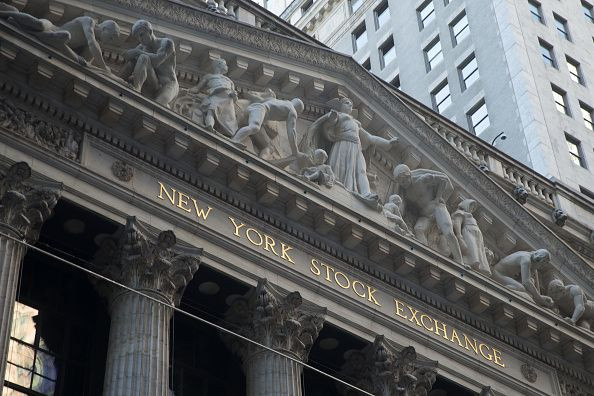Dow Jones Industrial Average Jumps On Surprise Move By Bank Of Japan; Oil Prices Jump

This story was updated at 4:33 p.m. EST.
A tumultuous month and a rough week in global markets ended Friday with a pop after the Bank of Japan surprised markets by joining a growing number of economies taking bold monetary measures to stimulate growth. U.S. shares surged more than 2 percent, giving a small bounce to the Standard & Poor's 500, which had its worst January since 2009.
The Dow (INDEXDJX:.DJI) closed up 396.66 points on Friday, or 2.47 percent, to 16,466.30. The broader S&P 500 index (INDEXSP:.INX) gained 46.88 points, or 2.48 percent, to 1,940.24. The Nasdaq composite (INDEXNASDAQ:.IXIC) rose 107.28 points, or 2.38 percent, to 4,613.95. The Dow and the S&P lost more than 5 percent this month, while the Nasdaq shed nearly 8 percent — its worst month in nearly six years.
With such a dismal start to 2016, the question is if the oft-cited adage “As January goes, so goes the year” will apply in 2016. January often signals trouble for the year, and after a seven-year bull run, 2016 could fit a historical pattern that suggests stock performance in the first month of the year is an indicator of the direction for the following 11 months.
But Bill Stone, chief investment strategist for PNC Wealth Management, contends poor performance in January doesn’t always mean a negative year for the stock market.
“I looked at the worst 10 starts to the year, and on average it ends up down for the entire year,” he said. “But five did show gains — so you can’t always throw away the year. History will tell you the year is not doomed just because you have a bad start.”
But after a seven-year bull run in U.S. stocks, fueled by record low interest rates, markets could be poised to enter bear territory, which is defined as a 20 percent drop in markets after a recent peak. The S&P is down about 8 percent since its Nov. 3 peak over the past six months.
Oil prices jumped Friday as speculation major oil producers might begin to cut production boosted optimism. But some of those gains were lost by Friday afternoon. Stock markets have been tracking oil prices more closely than they have in decades, a “rare coupling” in which investors use crude prices as primary measure of economic activity amid concerns of a global downturn.
The weaker-than-expected GDP number for the fourth quarter, which came in at 0.7 percent instead of the expected 0.9 percent, lifted optimism that the Fed will hold back on raising interest rates in March. It raised the rate to between 0.25 and 0.5 percent in December, the first hike in nearly a decade. A higher rate increases borrowing costs, driving down corporate profits. The record low rate has been a main factor in the seven-year bull run in stock markets.
U.S. West Texas Intermediate crude advanced Friday by 1.17 percent to $33.61 per barrel for March delivery on the New York Mercantile Exchange. Brent crude, the other major global benchmark, jumped 2.51 percent to $34.74 for March delivery on the London ICE Futures Exchange.
All 10 S&P 500 sectors ended Friday up, with the biggest gains in tech and financial services stocks. Visa Inc. (NYSE:V) led Dow 30 gains Friday, while Chevron Corp. (NYSE:CVX) led Dow declines.
The yield on the benchmark U.S. 10-year Treasury dropped to its lowest level since April before rebounding to 1.93 percent. The bond yield typically drops when investors are more worried about the economy. Gold, another so-called safe-harbor investment, dropped 0.19 percent to $1,117.70 per troy ounce. Gold prices tend to rise when optimism cools.
The Bank of Japan joined Sweden, Switzerland, Norway and the European Union in pushing their key interest rate below 0 percent, effectively paying banks to take money in a bid to stimulate lending and spur economic growth. Over a fifth of global economic growth is now coming from economies with negative key interest rates, according to the Wall Street Journal, a sign of the extreme measures being implemented to keep the global economy moving.
Global Markets
The surprise move by the world’s third-largest economy lifted Asian equities.
China’s broad CSI 300 Index closed up 3.24 percent by the closing bell in Asia Wednesday. The mainland Shanghai Composite Index followed suit, rising 3.09 percent. The smaller Shenzhen Composite jumped 3.53 percent. Hong Kong’s Hang Seng closed up 2.54 percent, while Japan’s Nikkei rose 2.8 percent.
European markets ended the month’s last trading day in the green. The broad Stoxx Europe 600 index gained 1.79 percent. The Paris-based CAC 40 edged up 2.19 percent, while London’s FTSE rose 2.56 percent and Frankfurt’s DAX gained 1.64 percent.
Market Movers
Amazon.com Inc. ( NASDAQ:AMZN ) shares dropped 7.61 percent on Friday after missing on earnings and profit in the three months ending in December. The company’s stock is up about 88 percent for the past 12 months and down about 14 percent since the start of the year.
Microsoft Corp. ( NASDAQ:MSFT ) shares rose 5.83 percent after it reported a strong holiday sales season for the quarter ended in December. Microsoft stock is up about 29 percent over the past 12 months and down about 2 percent since the start of the year.
Visa Inc. ( NYSE:V ) stock rose 7.05 percent after the credit card payment processor announced a 24 percent rise in profit in its fiscal first quarter. Visa shares are up about 17 percent over the past 12 months and down about 7 percent since the start of the year.
Shares in DuPont ( NYSE:DD ) dropped 1.44 percent after issuing a lower-than-expected 2016 earnings forecast. The company’s shares are down about 30 percent over the past 12 months and down about 24 percent since the start of the year.
© Copyright IBTimes 2024. All rights reserved.






















